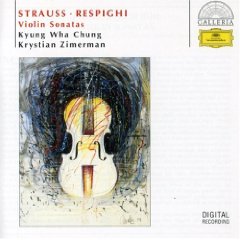Richard Strauss – Sonata for Violin and Piano Op.18 (1998)
Richard Strauss – Sonata for Violin and Piano Op.18 (1998)

01. Allegro
02. Andante cantabile
03. Finale. Andante- Allegro
Kyung Wha Chung - violin,
Krystian Zimerman – piano
Chamber works were not of particular interest to Richard Strauss once he had passed the gates to musical maturity. The Sonata for violin and piano in E flat major, Op. 18, of 1887 is really the last original chamber piece to come from Strauss' pen. After the Sonata there are only a handful of arrangements of music from the operas, a few lost or unfinished works, and two unassuming pieces that date from many decades later: the Allegretto for violin and piano and the Hochzeitspräludium for, believe it or not, two harmoniums. The Sonata is a nice treat -- the vast majority of late nineteenth century chamber sonatas were produced by the Brahms/Dvorák side of the great musical divide; only occasionally does one get to sample how a composer from the other "camp," in this case Strauss, felt about the genre.
The Sonata is roughly contemporaneous with the famous symphonic fantasy Aus Italien and the famous tone poem Don Juan, and the proximity is everywhere apparent in the music. Velvety melody and a certain refined manner of self-indulgence fill the pages of each of the work's three movements. However, in the finale the velvet is ruffled a bit, and that self-indulgence is in part replaced by self-willed urgency. The piano announces the beginning of the Allegro ma non troppo first movement with a gently heroic idea -- like an echo of some triumph long past -- whose basic contours will ultimately generate a fair portion of the movement's stock. A beautiful, flowing melody emerges some 20 bars later, but this is just a subsidiary to that opening idea. Another beautiful, flowing melody, this one in B flat major and marked espressivo e appassionato, serves as the proper second theme.
The second movement is called Improvisation and marked Andante cantabile. Improvised it is not: this is a very carefully crafted instrumental song. The finale begins with nine bars of sepulchral Andante introduction for the piano alone; Allegro is the tempo of the movement proper, whose initial, symphonic thrust is so compelling that it prompts the violin to explode with a frenzy of sixteenth notes. When everything has been said, the two instruments agree on blatant heroism for the close of the Sonata. ---Blair Johnston, Rovi
download: uploaded yandex 4shared mediafire solidfiles mega zalivalka filecloudio anonfiles oboom
Zmieniony (Środa, 14 Maj 2014 16:26)








